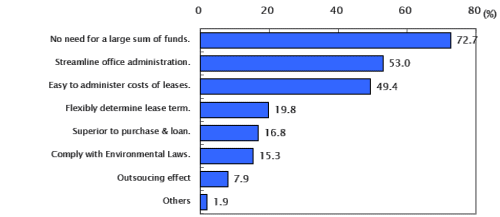Advantages of Leases
According to the survey conducted in 2010 by the Japan Leasing Association, the advantages of leases listed by entities are as follows.

No Need for a Large Sum of Funds in Acquiring Expensive Equipment, Which Enables an Entity to Make the Best Use of its Funds.
- If an entity chooses to acquire expensive equipment through lease, the entity does not need to initially invest a large sum of funds in that expensive equipment. Therefore, the entity is able to make the best use of its funds for the other purposes.
Streamline Office Administration.
- A SME (lessee) is only required to recognize the lease payments as lease expense.
-
For a large company (lessee) to which the lease accounting standard is applied, the company is able to streamline the burdensome accounting associated with finance leases if recognizing lease assets at the amount of total lease payments without discounting it at the present value. Under this accounting method, the company recognizes only depreciation expense and that amount is equal to the amount of lease payments. A large company is able to adopt this accounting method if the remaining balance of lease payments is less than 10%.
- A lessor calculates and pays personal property tax associated with leased assets. For personal property tax, entity needs to keep two books for PP&Es if the entity purchases PP&Es. This is why there is a difference between the carrying amount under the corporate tax and that under the personal property tax. If an entity acquires PP&Es through leases, the entity is able to mitigate the burden to keep two books for PP&Es.
Easy to Administer Costs Arising from Leases.
- It is easy for a SME (lessee) to account for leases because the SME is only required to recognize lease payments as lease expense in its profit and loss statement.
- For a large company (lessee) to which the lease accounting standard is applied, the company is able to adopt the simplified accounting method written above if the remaining balance of lease payments is less than 10%. If the remaining balance of lease payments is more than 10%, the company is required to apportion the lease payments between interest component and repayment of lease liability. This kind of company is also able to apply the simplified accounting method to the portion where the remaining balance of lease payments is less than 10%.
Lease Term is Flexibly Determined in Accordance with Term Over Which Lessee Intends to Use Equipment.
- A lessee is able to determine how long the lease term is based on the term over which the lessee intends to use the equipment regardless of the legal life of the equipment. However, the lease term should be more than 70% of the legal life under the lease taxation (if the legal life is more than 10 years, the lease term should be more than 60%.). Therefore, a lessee is able to flexibly determine how long the lessee uses the equipment based on the nature of the equipment (the limitation that the lease term should be less than 120% of the legal life has been abolished.).
- Lease expense is recognized over the lease term, over which the lessee intends to use the equipment, without being affected by the revision of depreciation-related taxation.
Comply with Environment-Related Laws.
- It is necessary to comply with environmental-related laws in disposing of equipment. If an entity acquires equipment through leases, the entity is only required to return the equipment to the lessor and then the lessor takes any responsibility for the disposal. Recently, this advantage has more entities interested in lease contracts.